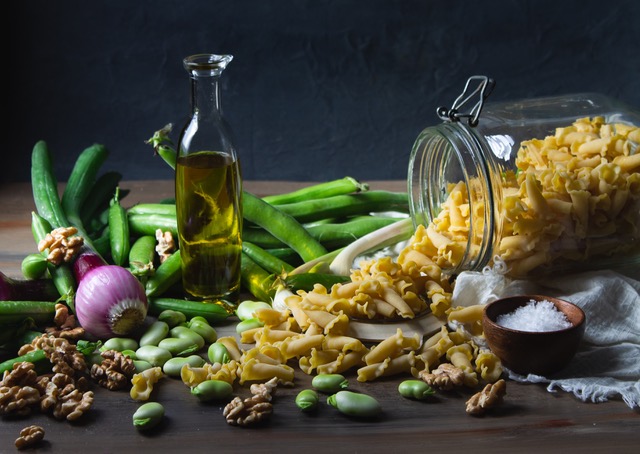Olive oil, known as “liquid gold” in ancient times, has been cherished for centuries due to its exceptional flavor, versatility, and numerous health benefits. Derived from the fruits of the olive tree (Olea europaea), this natural oil has a rich history and continues to captivate people worldwide. In this article, we delve into the origins of olive oil and explore the remarkable benefits it offers.
The origins of olive oil can be traced back to the Mediterranean region, where olive trees have been cultivated for thousands of years. Ancient civilizations, such as the Greeks and Romans, revered olive oil for its culinary and medicinal properties. The olive tree itself became a symbol of peace, wisdom, and fertility. The historical significance of olive oil extends beyond its traditional uses, as it played a crucial role in religious ceremonies and even served as an ancient currency.
Olive oil is extracted by pressing the olive fruit. The process involves several stages, beginning with the harvesting of ripe olives. The fruits are then washed and crushed to form a paste. The paste is subsequently pressed to separate the oil from the solid matter. This traditional method, known as cold-pressing, ensures that the oil retains its natural flavors, nutrients, and health-promoting compounds.
There are different types of olive oil, each with distinct characteristics and uses. Extra virgin olive oil, the highest quality and most sought-after type, is obtained solely through mechanical means and without any chemical processing. It possesses a superior taste, aroma, and a rich green color. Virgin olive oil is also obtained mechanically but has slightly higher acidity compared to extra virgin olive oil. Pure or refined olive oil undergoes further processing, including refining and filtering, to remove impurities and enhance its shelf life.
What Health Benefits does Olive oil have?
Heart Health: Olive oil is renowned for its heart-healthy properties. Its monounsaturated fats, such as oleic acid, can help lower bad cholesterol (LDL) levels while increasing good cholesterol (HDL). This, in turn, reduces the risk of heart disease and stroke.
Antioxidant Powerhouse: Loaded with powerful antioxidants, such as polyphenols and vitamin E, olive oil protects the body against oxidative stress, reducing inflammation and combating free radicals. These antioxidants contribute to various health benefits, including promoting healthy aging and reducing the risk of chronic diseases.
Anti-inflammatory Effects: Olive oil contains a natural compound called oleocanthal, which exhibits anti-inflammatory properties similar to non-steroidal anti-inflammatory drugs (NSAIDs). Regular consumption of olive oil has been linked to a decreased risk of inflammatory conditions, such as rheumatoid arthritis and certain cancers.
Digestive Health: The consumption of extra virgin olive oil has been associated with improved digestion and a reduced risk of digestive disorders. It can help stimulate the production of bile, aid in the absorption of nutrients, and promote a healthy gut microbiome.
Brain Function: Olive oil is considered a key component of the Mediterranean diet, which has been associated with a reduced risk of cognitive decline and neurodegenerative diseases, such as Alzheimer’s. The monounsaturated fats in olive oil help maintain healthy brain function and protect against age-related cognitive decline.
What kind of schemes the industry uses to produce a less expensive Olive oil?
While the vast majority of olive oil producers adhere to ethical and legitimate practices, it is important to acknowledge that, like any industry, there have been cases of fraudulent activities or deceptive schemes employed by a small number of individuals or companies. These schemes aim to mislead consumers and compromise the integrity of olive oil products.
Adulteration involves mixing olive oil with lower-quality oils or substances, such as seed oils or vegetable oils. This dilution allows unscrupulous producers to reduce costs while maintaining the appearance of pure olive oil. Adulterated oils may lack the health benefits and flavors associated with authentic olive oil.
Mislabeling, it occurs when producers intentionally misrepresent the origin, quality, or classification of their olive oil. For example, labeling a bottle as “extra virgin olive oil” when it does not meet the required standards or using misleading geographical indications to imply a specific origin that is inaccurate.
Counterfeiting, it involves creating imitation packaging or labels that resemble established and reputable olive oil brands. These counterfeit products are often of inferior quality and are sold at a lower price, deceiving consumers who believe they are purchasing a genuine product.
Some producers may use improper processing methods or machinery that compromise the quality of the olive oil. This can include using excessive heat during extraction or employing chemical solvents, resulting in a lower-quality oil with diminished nutritional value and flavor.
Olive oil classifications, such as extra virgin or virgin, have specific standards regarding acidity levels, sensory attributes, and production methods. Some producers may blend lower-quality oils with small amounts of higher-quality oils to achieve the desired classification, deceiving consumers and undermining the authenticity of the product.
It is important to note that these deceptive practices are not representative of the olive oil industry as a whole. Many reputable producers take pride in maintaining high-quality standards and adhering to strict regulations. In response to fraudulent practices, organizations, regulatory bodies, and certifications have been established to ensure the authenticity and quality of olive oil products, providing consumers with reliable choices.
What is the difference between a mono cultivar and a mixed cultivar olive oil?
Mono cultivar olive oil is made from a single variety of olives. In other words, the oil comes from olives of the same cultivar or variety, which are harvested and processed separately. This allows for the unique characteristics and flavors of that particular olive variety to be highlighted in the oil. Mono cultivar oils often showcase distinct aromas, flavors, and intensities, providing a more focused and specific tasting experience. Some popular mono cultivar varieties include Picual, Arbequina (Spain), Frantoio (Italy), and Koroneiki (Greece).
Mixed cultivar olive oil, also known as a blend or cuvée, is produced by combining olives from different cultivars or varieties. The blending process involves carefully selecting olives from different cultivars, either harvested separately or together, to create a harmonious and balanced flavor profile. By blending different varieties, producers aim to achieve a well-rounded and complex olive oil that showcases a combination of flavors, aromas, and intensities. The specific cultivars used in the blend can vary depending on the desired characteristics and the expertise of the producer.
Differences and Considerations:
Flavor Profile: Mono cultivar oils tend to have a more pronounced and distinct flavor profile, reflecting the characteristics of the specific olive variety. Mixed cultivar oils, on the other hand, offer a balanced and harmonious combination of flavors from different olives, resulting in a more complex taste.
Consistency: Mono cultivar oils provide a consistent flavor experience, as they are sourced from a single variety. Mixed cultivar oils may vary in taste from batch to batch or year to year, depending on the composition and proportion of different olive varieties used in the blend.
Versatility: Mixed cultivar oils often exhibit a versatile flavor profile that can complement a wide range of culinary applications. Mono cultivar oils, with their distinctive flavors, are sometimes preferred for specific dishes or pairings where their unique characteristics can shine.
Exploration: Mono cultivar oils offer an opportunity for olive oil enthusiasts to explore and appreciate the distinct qualities of different olive varieties. Mixed cultivar oils can provide a broader exploration of flavors and allow consumers to experience the artistry of blending different olives.
Both mono cultivar and mixed cultivar olive oils have their merits and can deliver exceptional taste experiences. The choice between the two depends on personal preferences, desired flavors, and intended culinary uses. Exploring and experimenting with different varieties and blends can enhance one’s understanding and enjoyment of olive oil.
What should we look for when purchasing a bottle of Olive Oil?
When purchasing a bottle of olive oil, it is essential for consumers to carefully examine the label to ensure they are getting a high-quality and authentic product.
Here are some key things to look for on the label:
Quality Classification: Check for the quality classification of the olive oil. The highest quality is “Extra Virgin Olive Oil,” followed by “Virgin Olive Oil.” These classifications indicate that the oil is made purely from olives and has undergone minimal processing.
Harvest Date: Look for the harvest date or “best before” date on the label. Freshness is crucial for olive oil, as it tends to deteriorate over time. Ideally, choose oils with a recent harvest date, typically within the last year.
Origin: Check for the country or region where the olives were grown and the oil was produced. Some regions have a reputation for producing high-quality olive oils, such as Italy, Spain, Greece, or California. Look for specific geographical indications or certifications like PDO (Protected Designation of Origin) or PGI (Protected Geographical Indication) that indicate the oil’s origin and quality.
Extraction Method: The label should mention that the oil was extracted using mechanical means, preferably “cold-pressed.” This indicates that the oil was obtained without excessive heat or the use of chemicals, preserving its quality and flavor.
Acidity Level: Extra virgin olive oil should have an acidity level below 0.8%. The label may indicate the acidity level, but it is not always required. However, a lower acidity level generally indicates higher quality.
Bottle Color: Olive oil is sensitive to light, so look for dark glass bottles or packaging that protects the oil from harmful UV rays. Light exposure can cause oxidation and deterioration of the oil.
Certification or Seals: Look for certifications or seals from reputable organizations or regulatory bodies. These may include the International Olive Council (IOC) seal, USDA Organic certification, or specific regional designations. These certifications provide an added assurance of quality and authenticity.
Tasting Notes: Some labels may include tasting notes or descriptors that provide information about the oil’s flavor profile. These can give you an idea of the oil’s aroma, fruitiness, bitterness, and pungency.
From its ancient roots to its modern-day prominence, olive oil has earned its place as a versatile and highly regarded ingredient in both culinary and wellness realms. Its remarkable health benefits, ranging from cardiovascular support to anti-inflammatory effects, make it an invaluable addition to a healthy lifestyle. So, embrace the rich history and harness the benefits of olive oil and let this liquid gold grace your table and enrich your well-being.
I hoped you enjoyed this article, let me know your experience on Olive oil write me at: attilio.borra@fbmagazine.co I’ll make sure to reply you for all the info you inquired.
This is it for now, until next time, I’ll see you in the Kitchen. Ciao.







